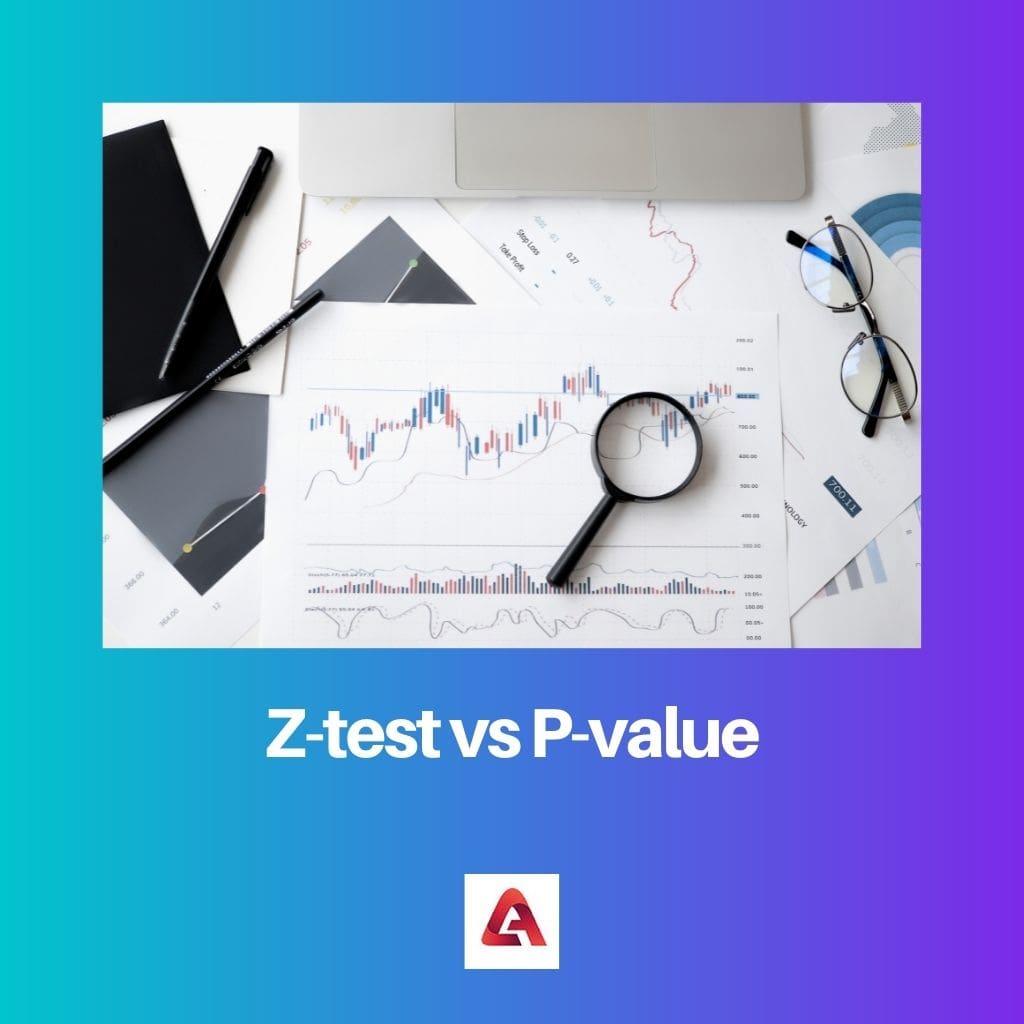Z- Test and P-Value are two statistical tests, but these are two separate things. Where the former is a statistical test that throws light upon whether one should reject the null hypothesis or not, whereas the latter is a probability test signifying there is a probability that the null hypothesis will be rejected.
Key Takeaways
- Statistical concepts: Z-test is a hypothesis test using the standard normal distribution. At the same time, the p-value represents the probability of observing a test statistic as extreme as the one obtained, assuming the null hypothesis is true.
- Purpose: Z-test is used to compare a sample statistic to a population parameter, while the p-value helps determine the test result’s significance.
- Decision-making: Z-test results in a test statistic (z-score), compared to a critical value; if the z-score is more extreme than the critical value, the null hypothesis is rejected. P-value aids this decision-making process by providing a probability measure.
Z-Test vs P-Value
The z-test is a hypothesis testing procedure used when the sample size is large, and the population standard deviation is known. The p-value is the probability of obtaining a test statistic as extreme or more extreme than the observed value, and is used for both large and small sample sizes.

A Z-test in statistics is a tool used to determine whether two population means vary even when the variables are known.
A null hypothesis is a general statement stating no relationship between the two measured groups.
Comparison Table
| Parameters of Comparison | P-Value | Z-Test |
|---|---|---|
| Meaning | The P-Value is the probability of the observations remaining the same or extreme if the null hypothesis is true. | Z-Test describes the deviation from the mean in units of standard deviation. |
| Assumptions | The P-Value is the test carried forward assuming the null hypothesis is true. | In the case of the Z-Test, it does not make such assumptions. |
| Objective | The objective of this test is to find out whether the null hypothesis should be accepted or not. | The objective of this test is to check if the observations remain the same or not and if the null hypothesis is true. |
| Indication of the test | The P-value indicates how unlikely the statistic is. | Whereas the Z-Test indicates how far the mean is. |
What is Z-Test?
A Z-test in statistics is a tool that is used to determine whether two population means vary even when the variables are known. Moreover, the sample size is large.
The Z-scores are the standard deviation measures; for example, +1.95 or -1.95 denotes how much the test statistic result has deviated from the mean.
There are a few assumptions that are made in the One-Sample Z-test:
- The data are continuous and not discrete.
- The data follow the normal probability distribution.

What is P-Value?
The P-Value is the probability of the test statistic result being rejected or accepted with an assumption of the null hypothesis being correct.
To find out the p-value in one’s statistic:
- Look up the statistic on the appropriate distribution.
- Find the probability that the mean is beyond your test statistic.
- If the hypothesis is less than the alternative, find the probability of the mean being less than your test statistic. This is the p-value.
Main Differences Between Z-Test and P-Value
Meaning
The P-Value is the probability of obtaining a test statistic result equal to or as extreme as a result observed in the experiment, assuming that the null hypothesis is true.
Whereas the Z-Test is the test used to determine whether the mean of a population is more significant than, less than, or equal to a specific value.
Null Hypothesis
In the case of the P-Value, the null hypothesis is assumed to be accurate, based on which the test statistic result observed in the experiment is checked to see if the result is the same or extreme as it was kept before.
Alternative Hypothesis
In the P-Value, the alternative hypothesis is the crucial statement that the experimenter wants to conclude in the experimental test if the data allows it.
Limitations
Moreover, the p-value tends to be concluded as significant or non-significant based on the p-value being less than or equal to 0.5, which is not the case with Z-Test. However, there are a few limitations to using the Z-Test.
The sample size may range from a small number to several hundred; if the data is discrete with at least five unique values, one may ignore the continuous variable assumption.
Results
Suppose the p-value is very small as compared to the threshold value that was previously chosen, known as the significant level (commonly 5% or 1%). In that case, it suggests that the observed data is inconsistent with the assumption that the null hypothesis is true. Thus, the hypothesis must be rejected, and the alternative hypothesis must be accepted.
For example:
- p < 0.1, the hypothesis is rejected
- 0.1<p<0.5, the hypothesis may or may not be rejected
- p>0.1, the hypothesis is accepted
In Z-Test, for example, The critical Z-Score values when using a 95% confidence level, -1.96 and +1.96 standard deviations.
If the Z score falls outside that range (for example, -2.5 or +5.4), the pattern exhibited is probably too unusual to be just another version of random chance, and the p-value will be small to reflect this.

While the article offers a comprehensive comparison between Z-Test and P-Value, it could delve deeper into discussing their individual significance in various fields of research and data analysis.
Good point, the article could be strengthened by incorporating insights into how these tests are used in different contexts and disciplines.
The article’s elucidation of the differences between Z-Test and P-Value is highly informative and contributes to fostering a deeper understanding of statistical testing methodologies.
Indeed, the extensive coverage of statistical concepts in the article facilitates a profound comprehension of statistical inference and hypothesis testing.
I concur, the article adeptly navigates the complexities of these statistical tests, enriching readers’ knowledge in the domain of data analysis.
The article effectively distinguishes between Z-Test and P-Value, shedding light on their purposes and decision-making capabilities in statistical analyses.
Precisely, the clarity provided in explaining the critical differences between these two tests is remarkable.
Agreed. This article serves as an informative resource for anyone seeking to understand statistical hypothesis testing.
The detailed analysis of Z-Test and P-Value presents a compelling argument for the necessity of these statistical tests in research methodologies.
Indeed, the precision in articulating the theoretical underpinnings of these tests highlights their indispensable role in empirical studies.
This article provides a clear and concise explanation of the concepts of Z-Test and P-Value, making it easier for readers to understand the complex statistical tests.
I agree, the comparisons and key takeaways are particularly helpful in understanding the fundamental differences between these two tests.
The article provides a definitive elucidation of Z-Test and P-Value, catering to readers seeking comprehension of these statistical tests in research methodologies.
Precisely, the article’s meticulous approach to detailing these statistical tests enriches readers’ knowledge in the domain of quantitative analysis.
The insightful discourse on Z-Test and P-Value escalates the article’s value as an educational resource for understanding fundamental statistical tests.
The article’s comprehensive coverage of Z-Test and P-Value is commendable, offering a coherent elucidation of these statistical tests and their utility in research methodologies.
Absolutely, the article’s erudite exposition on these statistical tests enhances readers’ proficiency in comprehending statistical inference and hypothesis testing.
The article effectively captures the nuances of Z-Test and P-Value, offering a comprehensive resource for those navigating statistical hypothesis testing.
Absolutely, the article’s structured approach enables readers to comprehend the intricacies of these statistical tools with clarity and coherence.
The logical progression of the content ensures that even individuals with limited statistical knowledge can grasp the core concepts of Z-Test and P-Value.
While the explanation is commendable, it lacks real-world examples to illustrate the application of Z-Test and P-Value in practical scenarios.
True, providing case studies or examples would greatly enhance the article’s effectiveness in conveying the significance of these statistical tests.
The article’s emphasis on delineating the attributes and functions of Z-Test and P-Value is praiseworthy, imparting valuable insights into the realm of statistical analysis.
Absolutely, the lucid elucidation of these statistical tests enhances readers’ comprehension of their pivotal role in evidence-based research.